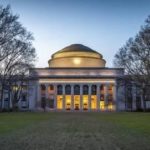Metropolitan Community College will spend $150,000 on a stainless steel art that stands 7 feet tall, emit sounds and literally reflect its surroundings. The piece is part of the three-building, $90 million project at the Fort Omaha campus. The buildings are open for business, but the work of art hasn’t been created yet by Berkeley, California, artist Po Shu Wang. The college and artist hope it will prove to be an excellent example of interactive public art.
Tucked away minutes from the North Freeway to the south and I-680 to the north is the historic Fort Omaha Campus on 30th and Fort streets, an instructional facility with 82,000 square feet of modern classroom, lab and student-dedicated space which opened in 1984. Obtained from the federal government in 1975, the campus is the oldest of the college system and serves as the second highest attendance site for students.
The majority of administrative and maintenance staff provide area-wide services from this location. The campus sits on 73 acres of land and contains 32 buildings, which encompass 377,701 square feet of space. The buildings and grounds are maintained in the original 19th century architectural theme, yet the classrooms and offices have been upgraded to accommodate new technology and educational needs of the 21st century.

The artist – Wang
Born in Hong Kong, Po Shu Wang is an artist working out of Berkeley, California. His art projects are site-oriented viruses. Each individual artwork is a specific strain that intimately linked with a particular host environment. They co-evolve, mutate, and conflict with their hosts within a larger reality. Wang is known for his spheres, kaleidoscopes and towers, which emit sounds that can be controlled to some degree by viewers. His work is found in California, Europe and Canada and at campuses such as Texas Tech and Oregon State.
Wang on the phone interview said that they were starting immediately. He said he would finish it in about four months. The piece will reflect the sky and earth around it, and the tones it emits will be affected by the gestures and movements of those standing next to it.
There are not many prominent Chinese multimedia artists but Wang is a master at it. Showcasing Wang’s early creations and new site specific installations, usually Wang is known to incorporate suspended or embedded light bulbs, metal containers, ink and other fluids to create kinetic installations that played with light, movement and the environment.
Influenced by his experience of geographical and cultural dislocation from his hometown of Beijing to New York, these works demonstrate sensitivity to material textures and explores how vernacular forms invoke cultural and geographical localities.
Wang, who was born in Hong Kong, educated in Europe and came to the United States 30 years ago, said he has about 30 pieces of public art on display around the world. Community colleges use private money and property tax funds for construction and renovation, and therefore don’t have to follow that law.

Wangs work of art.
Artworks situated outdoors. In 20th-century Western art, especially with the birth of abstract art, outdoor sculpture transcended its origins as monuments, memorials, and adornment for buildings, with artist building them as artworks independent of a specific purpose.
Nevertheless, the Metro board three years ago passed a resolution saying the two-year college should invest up to 1 percent of the cost of construction on art. Metro spokesman Derek Rayment said the money for the artwork came out of the $45 million that was donated for the three-building construction project. Susan Trinkle, chairwoman of Metro’s public art committee, said Wang’s concept won out of 80 applicants.
In general, public art occupies a unique position within the art world. In comparison with big-name gallery shows, public art is often underappreciated much like landscape architecture is. But there are lots to applaud because it is free for viewing. There are no tickets. People don’t have to dress up.
You can view it alone or in groups. It’s open to everyone. And in the metro community center the vote to create and have a public art on the campus was in high. And for this Trinkle, interim dean of humanities and the arts at Metro, said three finalists came to Omaha and made presentations. Out of which only wants art work impressed he committee members.

The Metropolitan Community College Campus
The committee liked the way Wang’s work is interactive in sight and sound. His work gave them more than simply a nice aesthetic according to the committee. They are so thrilled to have this piece coming to their campus. The artwork will be installed on a plaza between the new Construction Education Building and the Center for Advanced and Emerging Technology. This will be opened for viewing once it’s installed and opened.
Additional pieces will be placed in the three new buildings, including professional art and student art. There’s not a fixed number or cost yet, Trinkle said of the additional pieces. Wang, said he likes to interact with art and has no interest in creating pieces to which people can’t get close. He wants to be inspired by art, he said, and he wants to inspire others with his art.
Community art can also create attachment to one’s community. Hoping that this art piece will inspire each and everyone visiting it and it will community with them as and how the community center and the artist Wang wants it to.



What do you think?